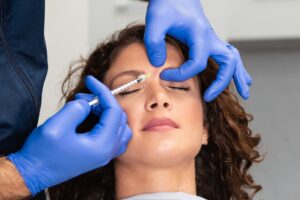
It may come as a surprise to learn that your dentist can offer BOTOX treatments, but it’s not as unusual as it seems. Many dentists become licensed to administer this treatment to address dental issues like TMJ (temporomandibular joint) disorders, migraines, and other concerns. While it does have a functional purpose, BOTOX is also widely used cosmetically to boost people’s appearance. Millions of Americans every year turn to this unique treatment to smooth out facial wrinkles and restore a more youthful visage. Though it’s a relatively common procedure in our current culture, it didn’t start that way. Keep reading to learn more about the origins of BOTOX and how it became the popular treatment it is today!
What Exactly Is BOTOX?
BOTOX is the trademarked name of a drug made from toxins produced by the bacterium Clostridium botulinum. It inactivates nerves that stimulate muscle contractions by preventing the release of the neurotransmitter, acetylcholine. Without it, muscle activity stops. In the wild, a botulism infection can paralyze your face, mouth, and throat, and eventually stop your breathing. Small, controlled injections administered by a trained professional, however, aren’t dangerous to your health. Your dentist can use it to smooth muscles underneath your face which allows your skin to relax, reducing fine lines.
When Was BOTOX Discovered?
Clostridium botulinum was first discovered by a Belgian scientist, Emile Pierre van Ermengem in 1895 following an outbreak among a band of musicians. By the 1920s, scientists at the University of California in San Franciso were the first to attempt to isolate its toxin. Despite their best attempts, no one had any success with this until Dr. Edward Schantz isolated it in crystalline form about 20 years later.
How Did Botox Develop?
In the 1970s, an American ophthalmologist named Dr. Alan Scott was researching possible treatments for strabismus (crossed eyes) and first injected the paralytic drug into a human in 1978. This successful experiment paved the way for other patients to safely use the product and it was approved by the FDA in 1989. It didn’t take long before it was used to cure jaw-clenching and migraines, too.
When Did Botox Become Cosmetic?
As more patients received this treatment for medical conditions, they noticed that it also helped remove wrinkles. Dr. Scott sold the rights to the drug in 1991 to a new distributor, Allergan, who rebranded the licensed treatment as Botox. In 1992, Dr. Alastair Carruthers and his wife, Dr. Jean Carruthers, issued the first report suggesting that it could be used for cosmetic purposes. By the 1990s it was known for helping people look younger as doctors grew more skilled in its administration. By 2002, it received FDA approval to treat frown lines, crow’s feet, and forehead folds. Today, BOTOX is the only neurotoxin that’s officially approved to enhance your appearance. It continues to grow in popularity as additional uses continue to evolve.
Though we tend to associate BOTOX with cosmetic procedures now, it began as a medical discovery. Today, your dentist is a licensed practitioner with decades of knowledge to pull from to help you preserve a more youthful appearance!
About the Practice
At Devonshire Dental of Boston, several dentists work together to provide families with a wide range of high-quality services. They take pride in helping patients enhance their lives by improving their overall well-being with their top-of-the-line treatments, including BOTOX injections. Dr. Christa Rizkallah specifically has specialized training in courses geared toward teaching the appropriate cosmetic applications, so you’re sure to get safe and effective results. If you’d like to reduce wrinkles, you’re welcome to request an appointment on the website or by calling (617) 350-7474.